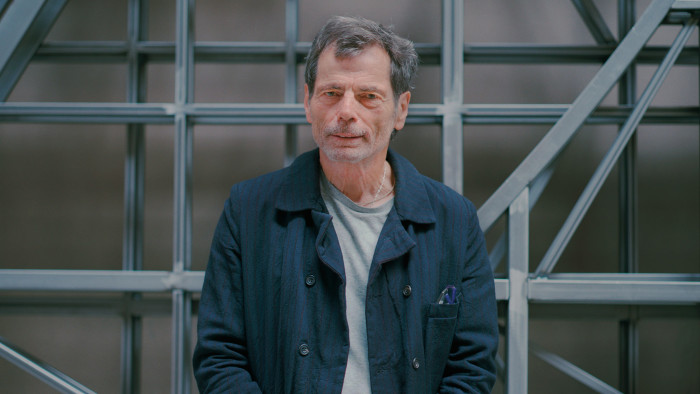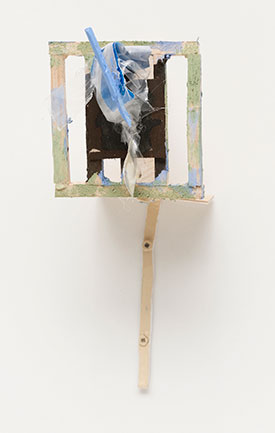Interview with Tate Modern artist Richard Tuttle

Simply sign up to the Life & Arts myFT Digest -- delivered directly to your inbox.
When Richard Tuttle was a little boy during the second world war, his father had a nervous breakdown. “He was a very sensitive man,” Tuttle recalls. “And in those days, if an able-bodied man was walking down the street not in uniform, everyone was thinking, ‘Why aren’t you fighting?’”
Shocked at his father’s behaviour, Tuttle went out on the stoop outside the family home in New Jersey. “I must have realised that my authority structure had disappeared,” he remembers. “And then I had this huge experience that really told me everything, everything, about my future, about what the world was, who I was, my energy, my direction.”
That precocious sense of autonomy fuelled his evolution into one of our most illustrious contemporary artists. A regular at the Venice Biennale and Documenta, he was the subject of a career retrospective in 2005 that travelled to museums across the US. Our meeting is prompted by two new exhibitions in London: a retrospective at Whitechapel Art Gallery and a new installation for the Turbine Hall at Tate Modern.
Home to one of the art world’s most prestigious commissions, the Turbine Hall’s previous incumbents include Tino Sehgal and Louise Bourgeois. Although Tuttle’s installation is still undergoing birth pangs, it looks like it might set a new high. As we stand in the cavernous hall swarming with builders, our words are all but drowned by the growl of drills. Slowly, a tidal wave of cinnabar-red cloth is hoisted upwards. Folded and stapled with intricate care on to a curved wooden plane suspended by cables from the ceiling, it is the first of a row of similar creations to make the ascent. “Look at that! It’s really amazing. Wow,” enthuses Tuttle as he watches.
Trying to pin Tuttle down on the final form his commission will take proves a challenge. “I think I’m a real problem for an interviewer,” he admits at one point in a husky whisper that is in keeping with his appearance. Blessed with delicate cheekbones dusted with stubble, deep-set eyes focused on some invisible horizon, Tuttle is today wearing jeans, baseball boots and an expensively crumpled navy jacket.

He doesn’t evade questions so much as start his reply several paragraphs later, or earlier, than expected. (His story of the vision on the stoop was prompted when I asked how he began as an artist, a journalistic inquiry that usually elicits a tale about childhood drawing skills.) Then the detour becomes a bewitching, Byzantine journey in itself.
That oblique grace is echoed in his work. Now in his 73rd year, Tuttle’s first major show was a survey in 1975 at the Whitney Museum in New York. By then he had tuned his art down to delicate, diminutive assemblies of modest components – string, cloth, plywood – which he handled with the same intensity that other artists applied to painting and sculpture. Some of his early pieces will be on view at the Whitechapel.
Today, a celebration of the humble is commonplace in contemporary art. But back then, such tentative expressions – which emerged out of Tuttle’s engagement with minimalists such as Agnes Martin – provoked ire. Visitors tried to rip works from the wall and curator Marcia Tucker was forced to resign.
Tuttle held his course. His frail encounters of shape, colour and texture sprang out of an awareness that earthly matter could serve as a conduit to metaphysical truths: “There’s a whole body of my works which starts with the material and then moves to the other sides where the material doesn’t matter.”
He tugs me over to the bolts of fabric still waiting to be unrolled. One is a piercing saffron yellow, the other a fathomless inky blue-black. “The idea is based on the passage of the day from dawn, through noon, to dark, which have been fundamental for art ever since the colours red, yellow and blue have been associated with them.”
The fabrics were sourced through Indian textile company Garden Vareli, and made in the Gujarat city of Surat, “where they have been making textiles for over 3,000 years, and yet at the same time they are all state of the art.”
The construction of the frame was overseen in London by Jim Leaver, formerly production manager at the Bristol Old Vic. Refusing to make a model in advance – “I was going for something I had in my head” – Tuttle is working his way towards the final ensemble through a blend of discipline and intuition. First he devised what sounds like a fiendishly complex set of rules that dictated how the cloth was to be attached. “It was like inventing a language,” he recalls.
Paradoxically, his “slavish” adherence to this system allowed him to enter the realm of the unknown. “The bottom line is to reach a seeability or a graspability that is in advance of something or other,” he tells me with majestic vagueness before clarifying himself. “Fabric always has a conceal/reveal aspect,” he says, twisting his hand back and forth to mime two sides of cloth, one visible, the other hidden. “And in between that reveal/conceal, there’s a mystery.”
His tone takes on a new authority. “Most people are afraid of mystery. We’ve got science, religion and philosophy, so that we never have to deal with it. Art might be there to help us form a more comfortable relationship with mystery.”
His love affair with textiles, which he also collects, started in the late 1960s. He sees fabric as “a superior form of paint” that allows him to pursue investigations into the rapport between colour and perception in ways denied by other media.
“In western culture, we tend to use black and white to solve structural relations,” he observes. “And we use colour just to fill in, like kids’ colouring books do. But certain cultures, such as the pre-Columbian, solve their structural problems with colour. Textiles are a very high art form for them [because they recognise that] the weave is structural.”
He hopes that his project will “work near ground, mid-ground and foreground”. Picking up a fold of the red cloth, he points out that tiny lozenge-shaped mirrors are embedded in it and they should create a striking luminosity when viewed from a certain distance.“I am making colour central and saying that through it, we can learn something about perception in general.
“Most people think science has nailed colour. That it’s just a question of light waves and so on. [But] artists have thought you could spend your entire life just thinking about colour – the infinity of colour.”
As he talks, I am reminded of the divide between Renaissance painters in Florence and Venice. The Tuscans, it was said, never put brush to panel without making a drawing first, while the Venetians plunged in and built their worlds out of pigment. As I gaze up at Tuttle’s rearing tsunami of red, I find myself reminded of the Assumption of the Virgin, the great altarpiece Titian painted for Venice’s Frari church which shows the Madonna sailing heavenwards in a billowing scarlet robe. In the 16th century, it caused a furore because red was viewed as too sensual a shade for this icon of chastity.
Tuttle, meanwhile, is telling me that “colour can connect you to all the features of humanity”. It may sound an ambitious statement but, with a little help from Titian, I find that I understand him perfectly.
‘Richard Tuttle: I Don’t Know, or The Weave of Textile Language’, Whitechapel Gallery, London, October 14-December 14, whitechapelgallery.org; Turbine Hall commission, Tate Modern, London, October 14-April 6 2015, tate.org.uk
Portrait by Howard Sooley
Comments